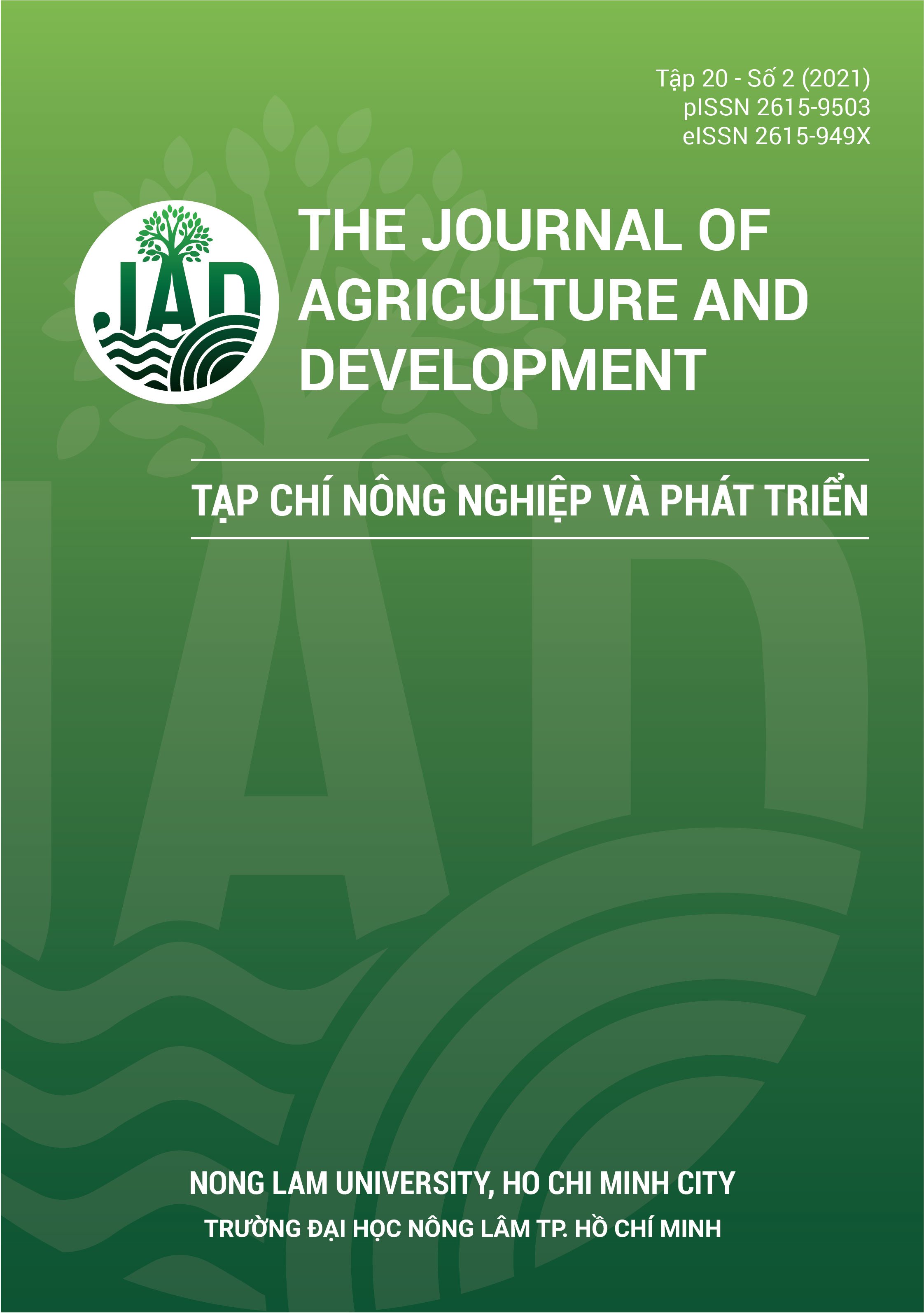Khảo sát khả năng sinh bacteriocin của vi khuẩn lactic phân lập trên nem chua Thủ Đức
Main Article Content
Tóm tắt
Mục đích của nghiên cứu là tuyển chọn được các chủng vi khuẩn lactic có khả năng sinh bacteriocin được phân lập trên nem chua tại Thủ Đức. Kết quả cho thấy có 2 trong số 8 chủng vi khuẩn lactic được phân lập, có khả năng sinh bacteriocin là Pediococcus pentosaceus trên nem chua Bà Chín lên men ngày thứ 3 và Weissella paramesenteroides trên nem chua Diễm lên men ngày thứ 5. Hoạt tính kháng khuẩn của chủng Pediococcus pentosaceus và chủng Weissella paramesenteroides được phát hiện bằng phương pháp khuếch tán thạch đều cho thấy hoạt tính đối kháng với cả 4 chủng vi sinh vật chỉ thị là Escherichia coli ATCC 25922, Salmonella enterica serova Typhimurium ATCC 13076, Staphylococcus aureus ATCC 6538 và Bacillus cereus ATCC 25924. Bacteriocin của chủng Pediococcus pen- tosaceus có khả năng kháng khuẩn tốt với đường kính vòng vô khuẩn tạo ra trung bình từ 12,20 - 16,07 mm. Đối với bacteri- ocin của chủng Weissella paramesenteroides chỉ cho thấy hoạt tính ức chế sự phát triển của các chủng vi sinh vật chỉ thị với đường kính vòng ức chế trung bình từ 9,75 - 15,27 mm. Tóm lại có thể ứng dụng 2 chủng vi khuẩn lactic này trong việc tạo ra các chế phẩm bacteriocin sinh học thay thế các chất bảo quản hóa học kéo dài thời gian sử dụng sản phẩm thực phẩm.
Article Details
Tài liệu tham khảo
Bajpai, V. K., Han, J. H., Rather, I. A., Majumder, R., Nam, G. J., ChanSeo, P., Lim, J., Paek, W. K., & Park, Y. H. (2016). Characterization of lactic acid bacterium Pediococcus pentosaceus 4I1 from freshwater fish Zacco koreanus and its antibacterial mode of action. PeerJ PrePrints 4, e2121v1. https://doi.org/10.7287/peerj.preprints.2121v1
Ceylan, E., & Fung, D. Y. C., 2007. Antimicrobial activity of spices 1. Journal of Rapid Methods and Automation in Microbiology 12(1), 1-55. https://doi.org/10.1111/j.1745-4581.2004.tb00046.x
Hoa, T. T. M., & Nguyen, A. L. (2012). Classify of bacteria lactococcus PD14 synthesized bacteriocin. Vietnam Journal of Science and Technology 50(5), 635.
Mathara, J. M., Schillinger, U., Kutima, P. M., Mbugua, S. K., & Holzapfel, W. H. (2004). Isolation, identification and characterisation of the dominant microorganisms of kule naoto: the Maasai traditional fermented milk in Kenya. International Journal of Food Microbiology 94(3), 269-278. https://doi.org/10.1016/j.ijfoodmicro.2004.01.008
Nguyen, D. T. L., Hoang, V. T., Nguyen, T. T. T., & Nguyen, A. H. (2016). Isolation and selection of lactic acid bacteria from Vietnamese fermented pork meat product with antimicrobial activity and characterization of bacteriocin. Vietnam Journal of Agricultural Science 14(7), 1089-1099.
Nguyen, D. T. L., Van Hoorde, K., Cnockaert, M., De Brandt, E., Aerts, M., Thanh, L. B., & Vandamme, P. (2013). A description of the lactic acid bacteria microbiota as- sociated with the production of traditional fermented vegetables in Vietnam. International Journal of Food Microbiology 163(1), 19-27. https://doi.org/10.1016/j.ijfoodmicro.2013.01.024
Papagianni, M., & Papamichael, E. M. (2011). Purification, amino acid sequence and characterization of the class IIa bacteriocin weissellin A, produced by Weissella paramesenteroides DX. Bioresource Technology 102(12), 6730-6734. https://doi.org/10.1016/j.biortech.2011.03.106
Pilasombut, K., Rumjuankiat, K., Ngamyeesoon, N., & Le, D. N. D. (2015). In vitro characterization of bacteriocin produced by lactic acid bacteria isolated from Nem Chua, a traditional Vietnamese Fermented Pork. Korean Journal for Food Science of Animal Resources 35(4), 473-478. https://doi.org/10.5851/kosfa.2015.35.4.473
Woraprayote, W., Malila, Y., Sorapukdee, S., Swetwiwathana, A., Benjakul, S., & Visessanguan, W. (2016). Bacteriocins from lactic acid bacteria and their applications in meat and meat products. Meat Science 120, 118-132. https://doi.org/10.1016/j.meatsci.2016.04.004








